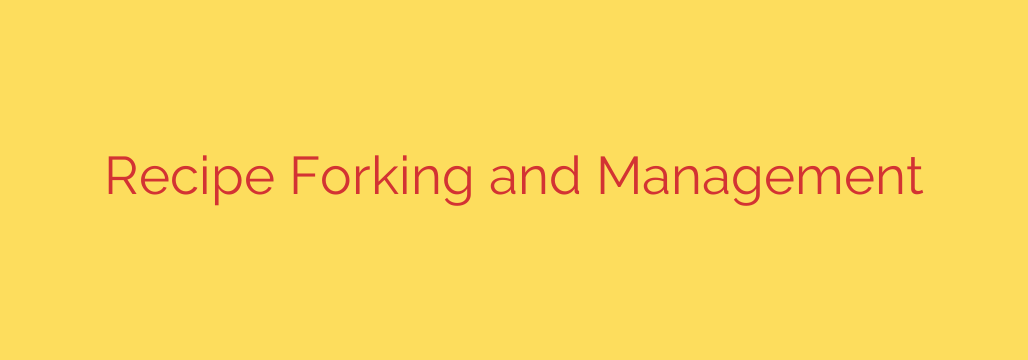
Beyond Bookmarks: The Smart Way to Manage and Adapt Your Favorite Recipes
We’ve all been there. You find the perfect recipe online, try it, and make a few brilliant tweaks. Maybe you swapped honey for maple syrup or added a dash of cayenne for a kick. You promise yourself you’ll remember the changes for next time. Months later, you can’t find the original bookmark, let alone recall your inspired adjustments. Your culinary genius is lost to the chaos of browser tabs and scribbled-on napkins.
This common frustration highlights a need for a more robust way to organize our cooking lives. The solution lies in adopting a systematic approach to not just storing, but also evolving your recipes. It’s a process that borrows a concept from software development: recipe forking.
What Exactly is Recipe Forking?
In the world of coding, “forking” means taking a copy of source code and developing it in a new direction. In the kitchen, it’s the exact same principle. Recipe forking is the act of taking an original recipe and creating your own distinct version.
Every time you do one of the following, you are essentially forking a recipe:
- Adjusting seasoning levels to your taste.
- Substituting an ingredient due to an allergy or preference.
- Scaling a recipe up or down for a different number of guests.
- Adding a new component to make the dish your own.
This is something great cooks do instinctively. By giving it a name, we can start to think strategically about how to manage these valuable new creations instead of letting them disappear.
The Old Way Doesn’t Work Anymore
For years, the methods for managing recipes have been clunky and inefficient. If you’re still relying on these, you’re likely creating more work for yourself.
Common problems include:
- An overflowing bookmark folder: Impossible to search and prone to broken links when websites go down.
- Printing everything: This creates physical clutter and makes it difficult to find what you need without a perfect filing system.
- Scattered notes: Annotations on printouts, in notebooks, or in a notes app are disconnected from the original recipe, making them hard to track.
These methods fail because they don’t create a single, searchable source of truth for your cooking.
The Modern Solution: A Digital Recipe Manager
The key to mastering your recipes is to embrace a dedicated digital recipe manager. These platforms are designed specifically for cooks and offer a powerful set of tools that go far beyond simple storage. A good digital manager becomes your centralized and permanent culinary library.
When choosing a recipe management tool, look for these essential features:
- Web Clipper/Importer: This is the most critical feature. It allows you to instantly pull a recipe from almost any website and save it in a clean, standardized format, stripping away ads and lengthy blog intros.
- Powerful Editing and Notes: A great manager lets you easily edit ingredients, instructions, and add permanent notes. This is where you’ll manage your “forks”—simply duplicate the original recipe and start making your changes in the new version.
- Smart Ingredient Scaling: Automatically calculate ingredient quantities whether you’re cooking for two or for twenty.
- Meal Planning and Shopping Lists: Many tools integrate with a calendar for meal planning and can automatically generate a shopping list from your chosen recipes.
- Tagging and Organization: Go beyond “Dinner” or “Dessert.” Use tags to categorize recipes by cuisine (
#Italian), occasion (#Holiday), or dietary need (#GlutenFree), making it effortless to find exactly what you want. - Cross-Device Sync: Access your entire recipe collection on your phone, tablet, or computer, ensuring you have what you need whether you’re at the grocery store or in the kitchen.
A Practical Workflow for Recipe Management
Here is a simple, actionable workflow you can adopt today:
- Choose Your Tool: Select a well-regarded recipe manager. Popular options include cloud-based apps like Paprika or AnyList, as well as self-hosted platforms like Mealie or Tandoor.
- Import, Don’t Bookmark: The next time you find a recipe you want to try, use your app’s web clipper to import it immediately.
- Fork Before You Cook: Before you make any changes, create a duplicate of the original recipe. This preserves the source while giving you a clean slate for your version.
- Rename and Annotate: Give your forked recipe a clear, new title (e.g., “Dad’s Chili – My Extra Spicy Version”). Use the notes section to detail exactly what you changed and why. For example: “Swapped butter for olive oil. Used 1 tsp of smoked paprika instead of regular.”
- Tag and Save: Add relevant tags and save your new creation. Now, both the original and your improved version are stored, organized, and easily searchable in your library.
A Quick Note on Security and Data Control
When choosing a platform, consider who controls your data.
- Cloud-Based Apps: These are incredibly convenient, require no technical setup, and sync automatically. The tradeoff is that your recipe data lives on a company’s servers.
- Self-Hosted Solutions: For those who are more tech-savvy, self-hosted platforms offer complete control and privacy. Your recipes are stored on your own server or home computer. This means you own your data outright and are not dependent on a third-party company staying in business.
By adopting a digital recipe manager and the “forking” mindset, you can transform your cooking. You’ll build a reliable, personal, and ever-growing library of recipes that truly belong to you. This organized approach removes the stress of finding information and frees you up to focus on what matters most: creating delicious food.
Source: https://www.linuxlinks.com/fork-recipes-manage-food-recipes/








